目录
一、stack
1.1 stack 的介绍
1.2 stack的使用
1)最小栈
2)栈的弹出压入序列
3)逆波兰表达式求值
1.3 stack 的模拟使用
二、queue
2.1 queue的介绍
2.2 queue的使用
2.3 queue的模拟使用
三、容器适配器
3.1 什么是容器适配器
3.2 STL标准库中stack 和 queue的底层结构
四、deque
4.1 deque的原理介绍
4.2 deque的缺陷
4.3 为什么选择 deque 作为stack 和 queue的底层默认容器
五、priority_queue
5.1 priority_queue的介绍
5.2 priority_queue的使用
1)数组中第K个大的元素
5.3 priority_queue的模拟实现
一、stack
1.1 stack 的介绍
stack文档 : stack - C++ Reference
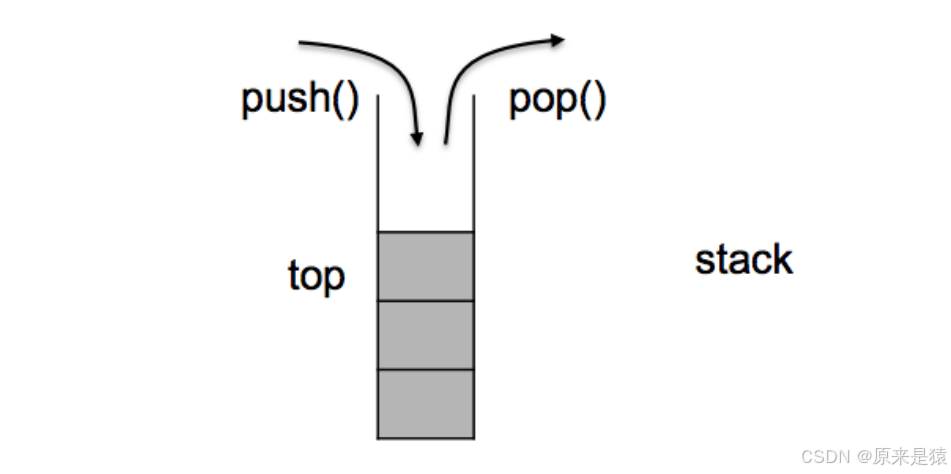

stack 不支持适配器 , 因为需要满足 后进先出的 特性 :
相关接口如下:
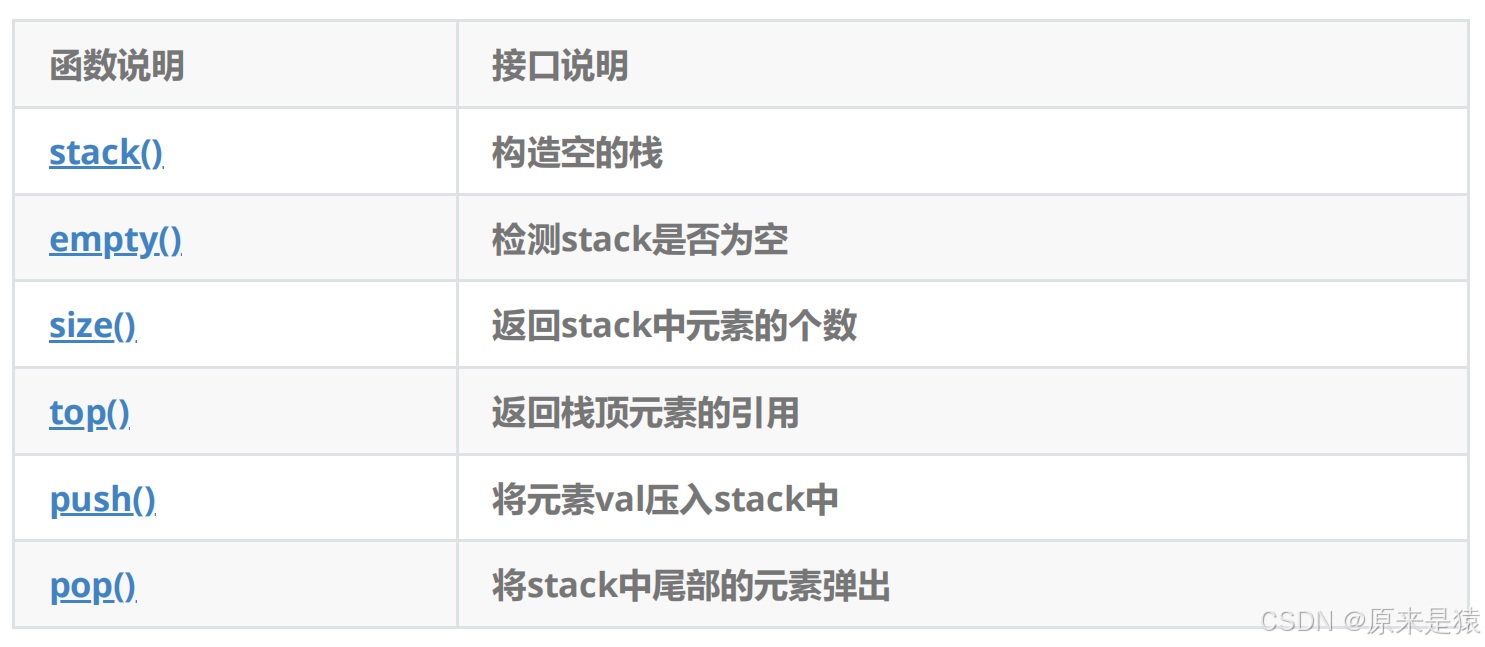
#define _CRT_SECURE_NO_WARNINGS 1
#include<iostream>
#include<stack>
using namespace std;int main()
{stack<int> st;st.push(1);st.push(2);st.push(3);st.push(4);while (!st.empty()){cout << st.top() << " ";st.pop();}cout << endl;return 0;
}1.2 stack的使用
1)最小栈
155. 最小栈 - 力扣(LeetCode)
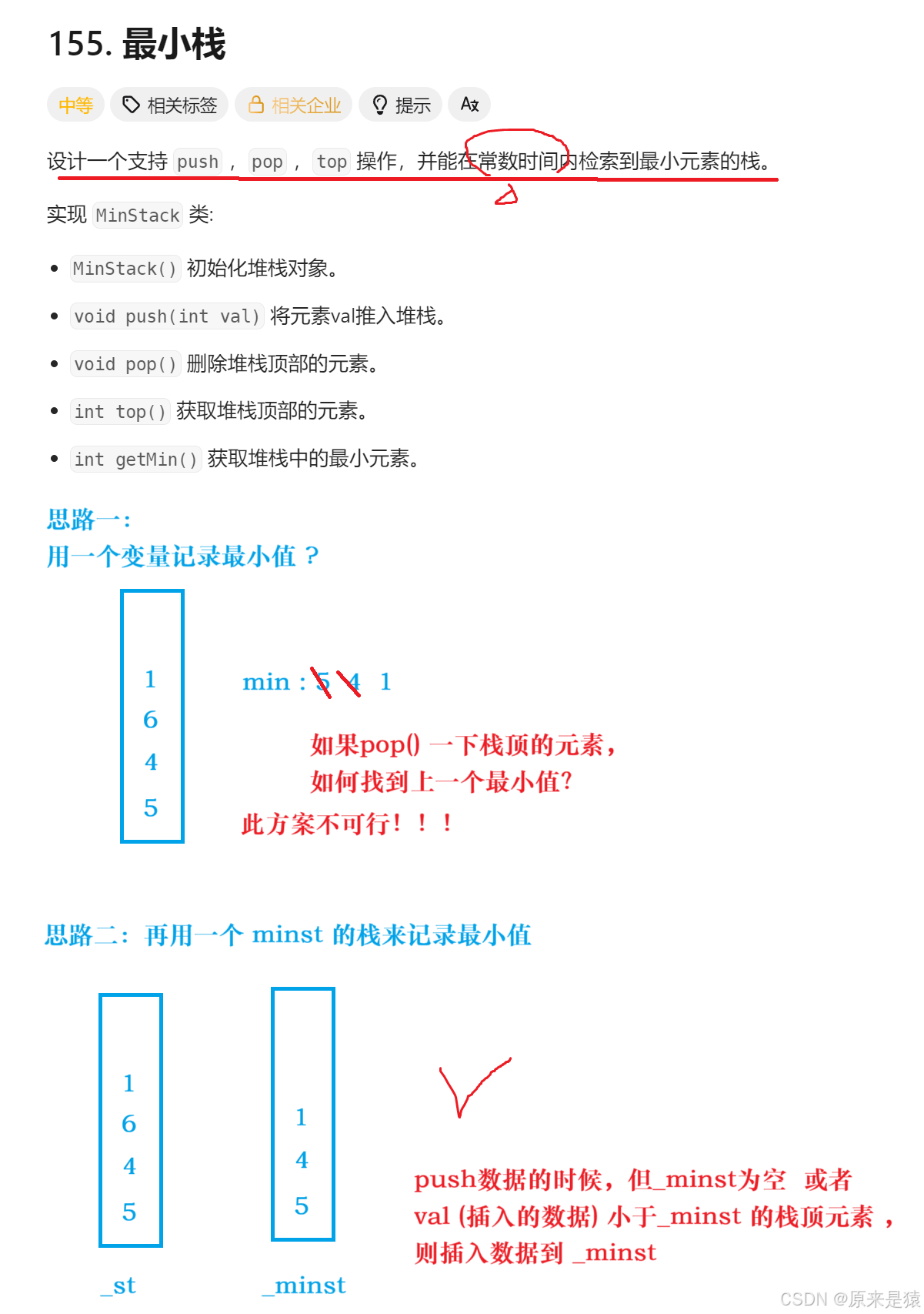
class MinStack {
public:void push(int val) {_st.push(val);if(_minst.empty() || val <= _minst.top())_minst.push(val);}void pop() {if(_st.top() == _minst.top())_minst.pop();_st.pop();}int top() {return _st.top();}int getMin() {return _minst.top();}stack<int> _st;stack<int> _minst;
};
2)栈的弹出压入序列
栈的压入、弹出序列_牛客题霸_牛客网
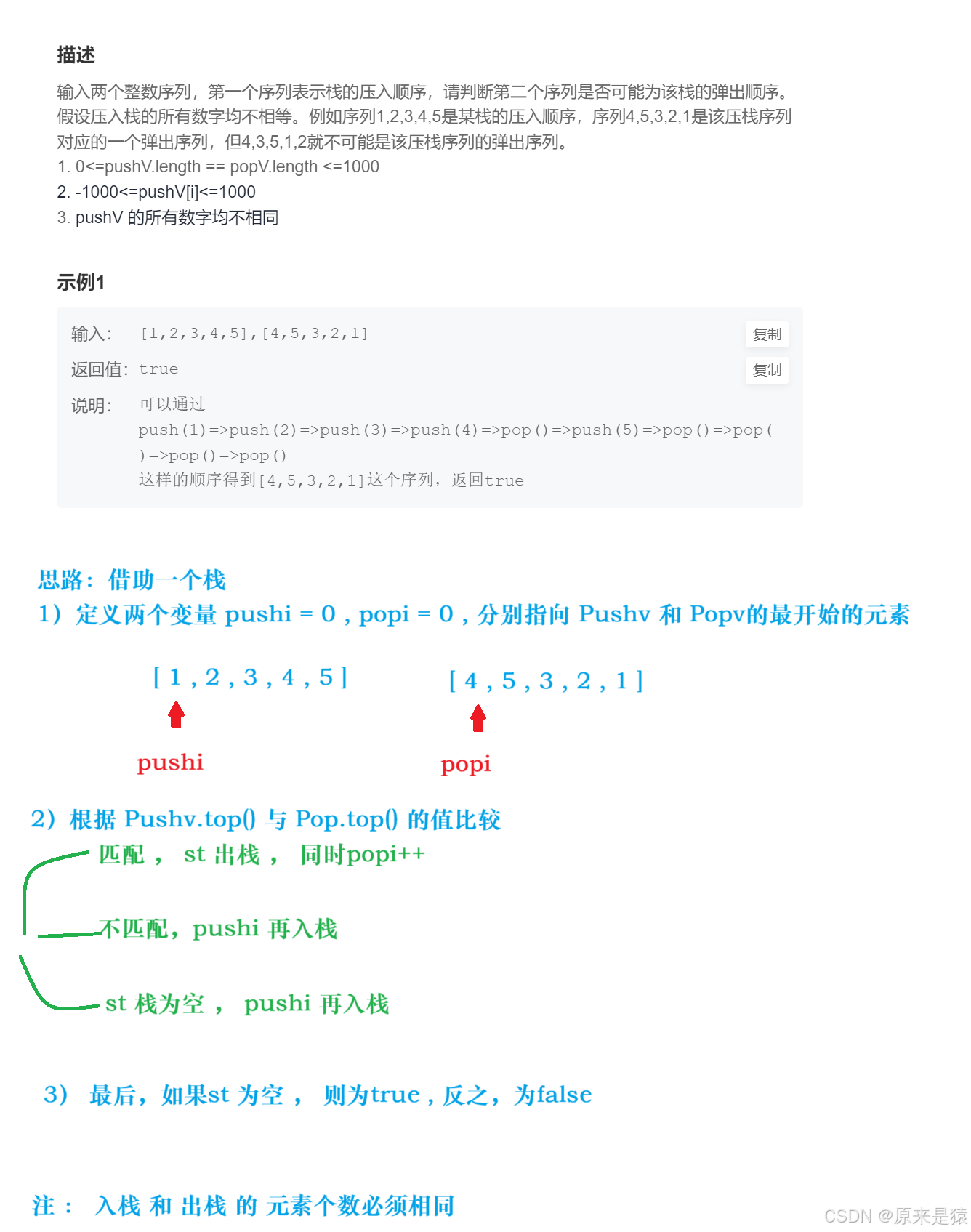
class Solution {
public:/*** 代码中的类名、方法名、参数名已经指定,请勿修改,直接返回方法规定的值即可** * @param pushV int整型vector * @param popV int整型vector * @return bool布尔型*/bool IsPopOrder(vector<int>& pushV, vector<int>& popV) {stack<int> st;size_t pushi = 0,popi = 0;while(pushi < pushV.size()){st.push(pushV[pushi++]);while(!st.empty() && st.top() == popV[popi]){st.pop();popi++;}}return st.empty();}
};3)逆波兰表达式求值
150. 逆波兰表达式求值 - 力扣(LeetCode)
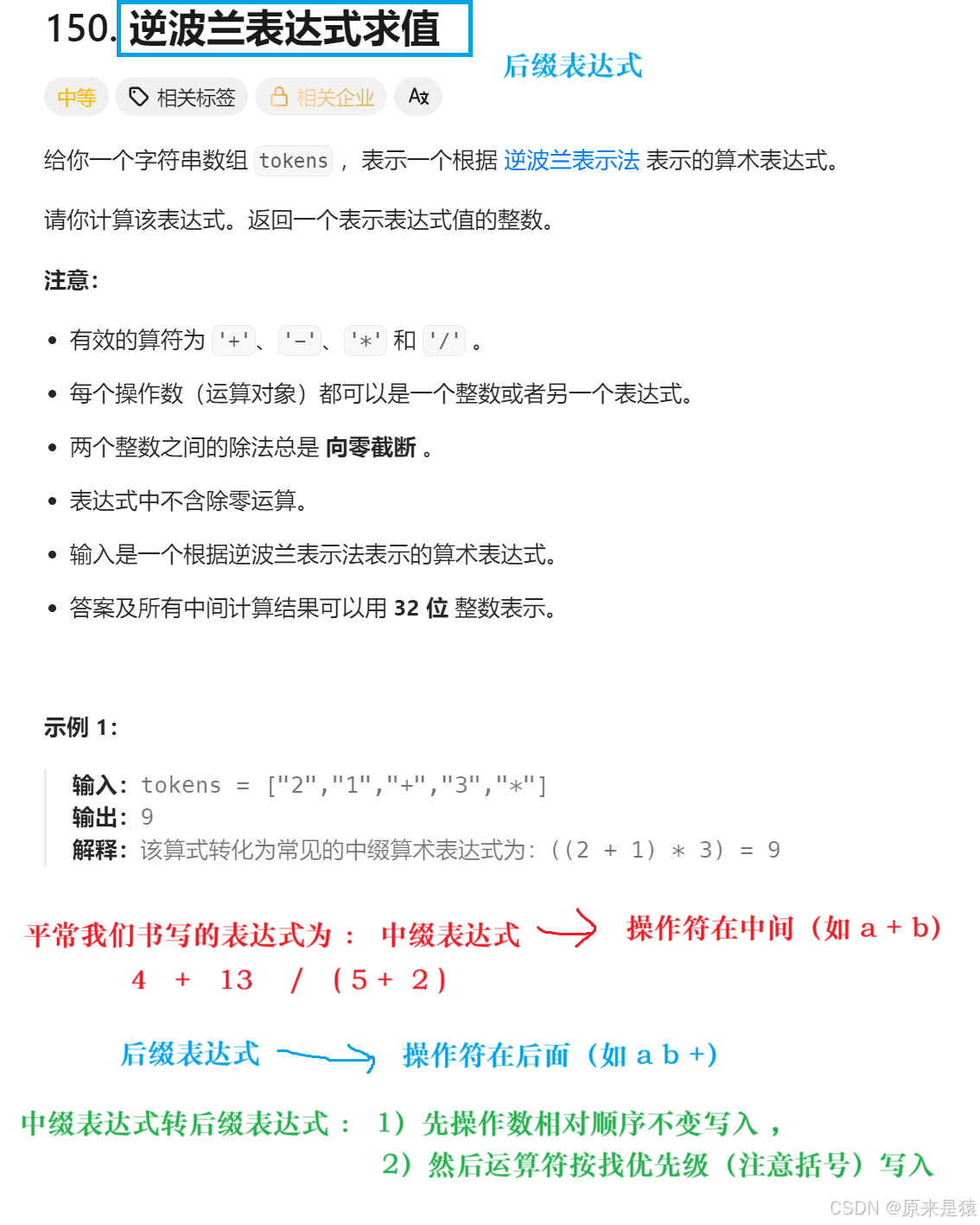
为了更加方便理解,下面是有关中缀表达式 转 后缀表达式 的 题目 ,加深理解 。
| 题号 | 中缀表达式 | 后缀表达式 |
|---|---|---|
| 1 | a + b - c | a b + c - |
| 2 | x * y / z | x y * z / |
| 3 | 3 + 5 * 2 | 3 5 2 * + |
| 4 | 10 - 6 / 3 | 10 6 3 / - |
| 5 | (a + b) * c | a b + c * |
| 6 | x / (y - z) | x y z - / |
| 7 | (3 + 5) * 2 - 4 | 3 5 + 2 * 4 - |
| 8 | 10 - (2 * 3 + 5) | 10 2 3 * 5 + - |
| 9 | a + (b * c - d) / e | a b c * d - e / + |
| 10 | ( (3 + 5) * 2 ) / (10 - 8) | 3 5 + 2 * 10 8 - / |
| 11 | x * (y + z) - w / v | x y z + * w v / - |
| 12 | (a - b) * (c + d / e) | a b - c d e / + * |

class Solution {
public:int evalRPN(vector<string>& tokens) {stack<int> st;for(auto & str:tokens){if(str == "+" || str == "-" || str == "*" || str == "/"){int right = st.top();st.pop();int left = st.top();st.pop();switch(str[0]){case '+':st.push(left + right);break;case '-':st.push(left - right);break;case '*':st.push(left * right);break;case '/':st.push(left / right);break;}}else{st.push(stoi(str));}}return st.top();}
};1.3 stack 的模拟使用
通过复用来实现相关接口 ,
stack.h
#pragma oncenamespace LF
{template<class T, class Container>class stack{public:void push(const T& x){_con.push_back(x);}void pop(){_con.pop_back();}const T& top()const{return _con.back();}size_t size() const{return _con.size();}bool empty() const{return _con.empty();}private:Container _con;};
}test.cpp 测试:
#define _CRT_SECURE_NO_WARNINGS 1
#include<iostream>
#include<vector>
#include<list>
#include"Stack.h"
using namespace std;int main()
{//LF::stack<int,vector<int>> st;LF::stack<int,list<int>> st;st.push(1);st.push(2);st.push(3);st.push(4);while (!st.empty()){cout << st.top() << " ";st.pop();}cout << endl;return 0;
}二、queue
queue文档:queue - C++ Reference
2.1 queue的介绍
1. 队列是一种容器适配器,专门用于在 FIFO上下文(先进先出) 中操作,其中从容器一端插入元 素,另一端提取元素 .2. 队列作为 容器适配器 实现,容器适配器即将特定容器类封装作为其底层容器类,queue提供一组特定的成员函数来访问其元素。元素从队尾入队列,从队头出队列。3. 底层容器可以是标准容器类模板之一,也可以是其他专门设计的容器类。该底层容器应至少支持以下操作 :
- empty:检测队列是否为空
- size:返回队列中有效元素的个数
- front:返回队头元素的引用
- back:返回队尾元素的引用
- push_back:在队列尾部入队列
- pop_front:在队列头部出队列

2.2 queue的使用
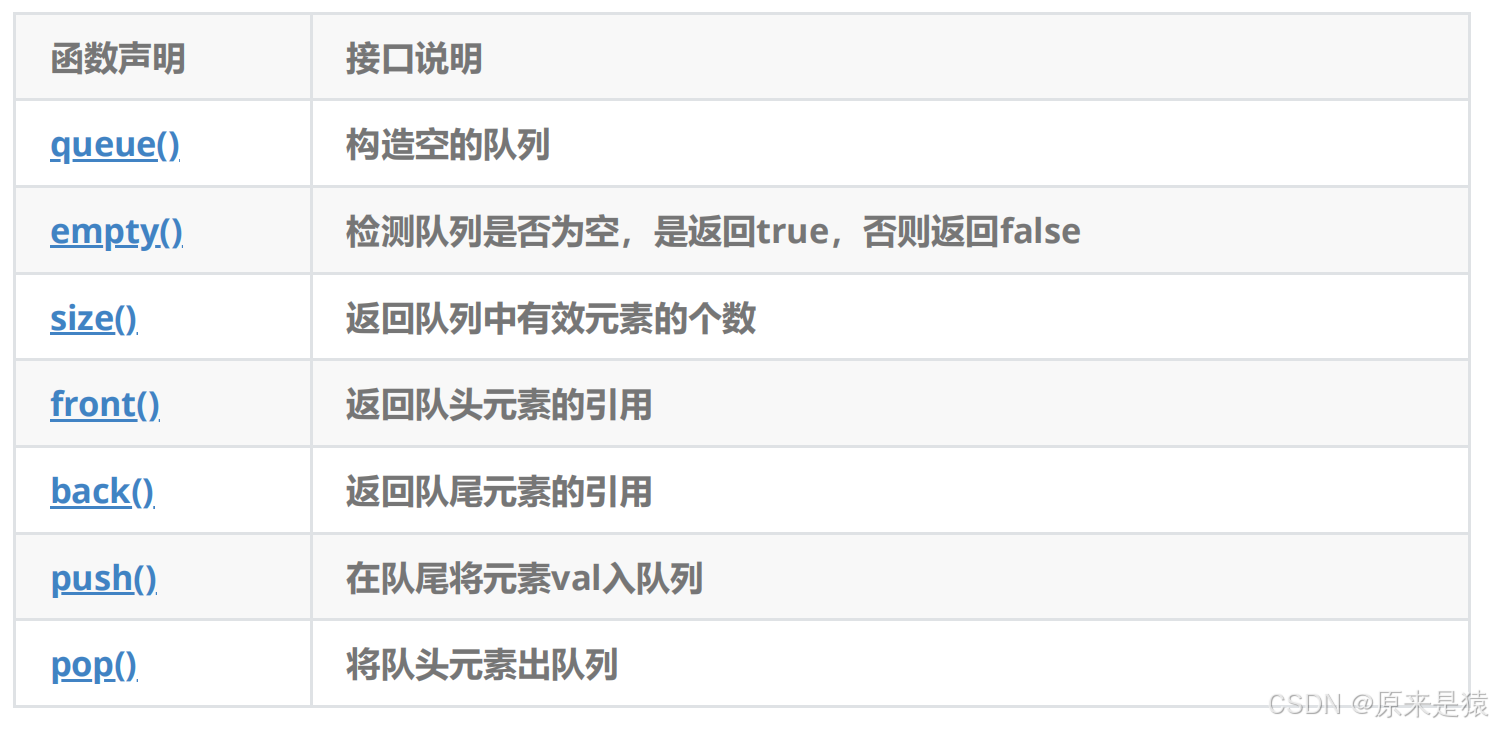
2.3 queue的模拟使用
注意 : vector 不能匹配队列 , 因为 vector 不支持头删
queue.h
#pragma once
#include<deque>namespace LF
{template<class T, class Container = deque<T>>class queue{public:void push(const T& x){_con.push_back(x);}void pop(){_con.pop_front();}const T& front() const{return _con.front();}const T& back() const{return _con.back();}size_t size() const{return _con.size();}bool empty() const{return _con.empty();}private:Container _con;};
}
test.cpp测试
#define _CRT_SECURE_NO_WARNINGS 1
#include<iostream>
#include<stack>
#include<queue>
#include<vector>
#include<list>
#include"Stack.h"
using namespace std;
#include"queue.h"int main()
{LF::queue<int, list<int>> q;q.push(1);q.push(2);q.push(3);q.push(4);while (!q.empty()){cout << q.front() << " ";q.pop();}cout << endl;return 0;
}三、容器适配器
3.1 什么是容器适配器
适配器是一种设计模式 (设计模式是一套被反复使用的 、 多人知晓的 、 经过反复编目的 、 代码设计经验的总结) , 该模式就是将一个类的接口转换成客户希望的另外一个接口 。
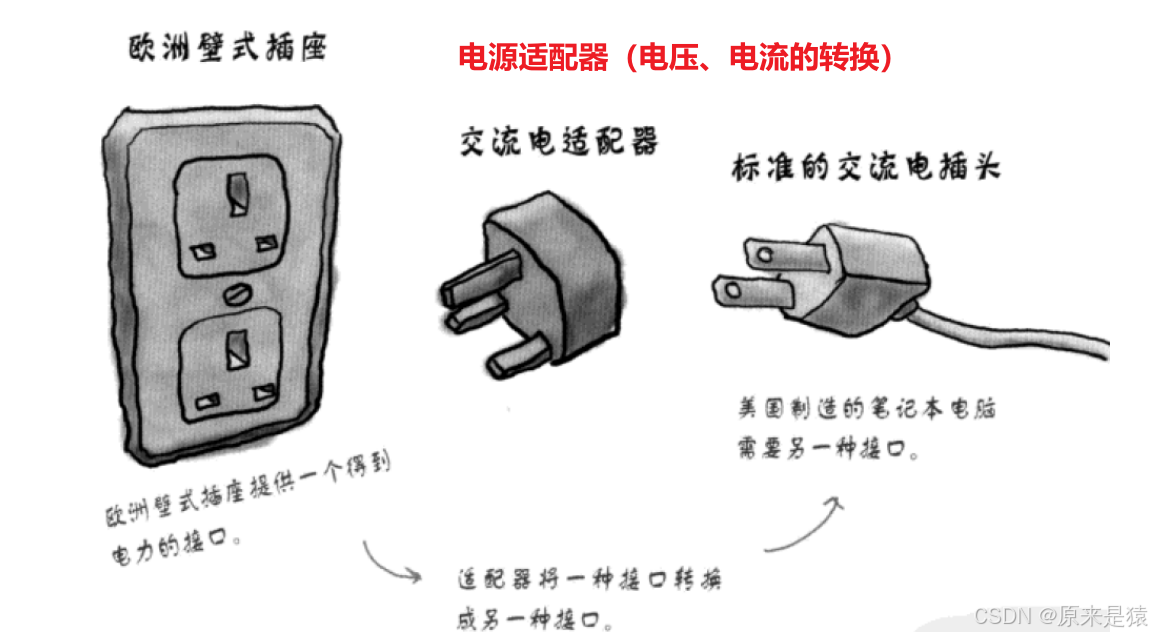
3.2 STL标准库中stack 和 queue的底层结构
虽然 stack 和 queue中 也可以存放元素 , 但在 STL中并没有将其划分在容器的行列 , 而是将其称为容器适配器 , 这是因为 stack 和 队列只是对其他容器的接口进行了包装 , STL中stack 和 queue 默认 使用 deque , 如下 :
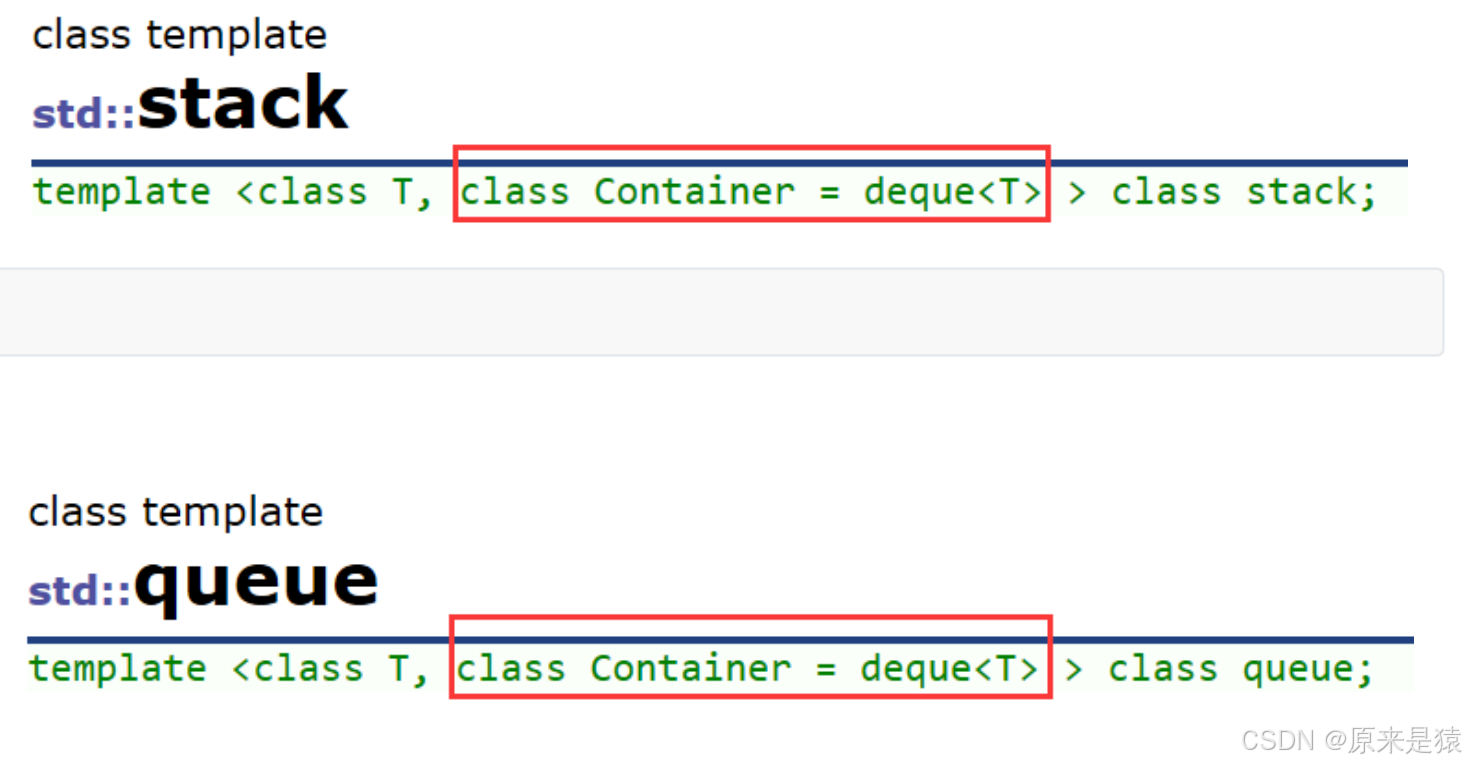

四、deque
4.1 deque的原理介绍
deque - C++ Reference
deque(双端队列) : 是一种双开口的“连续” 空间的数据结构 , 双开口的含义是 : 可以在头尾两端进行插入和删除操作 , 且时间复杂度为O(1) , 与 vector 比较 , 头插效率高 , 不需要搬移元素 ; 与list 比较 , 空间利用率高 。
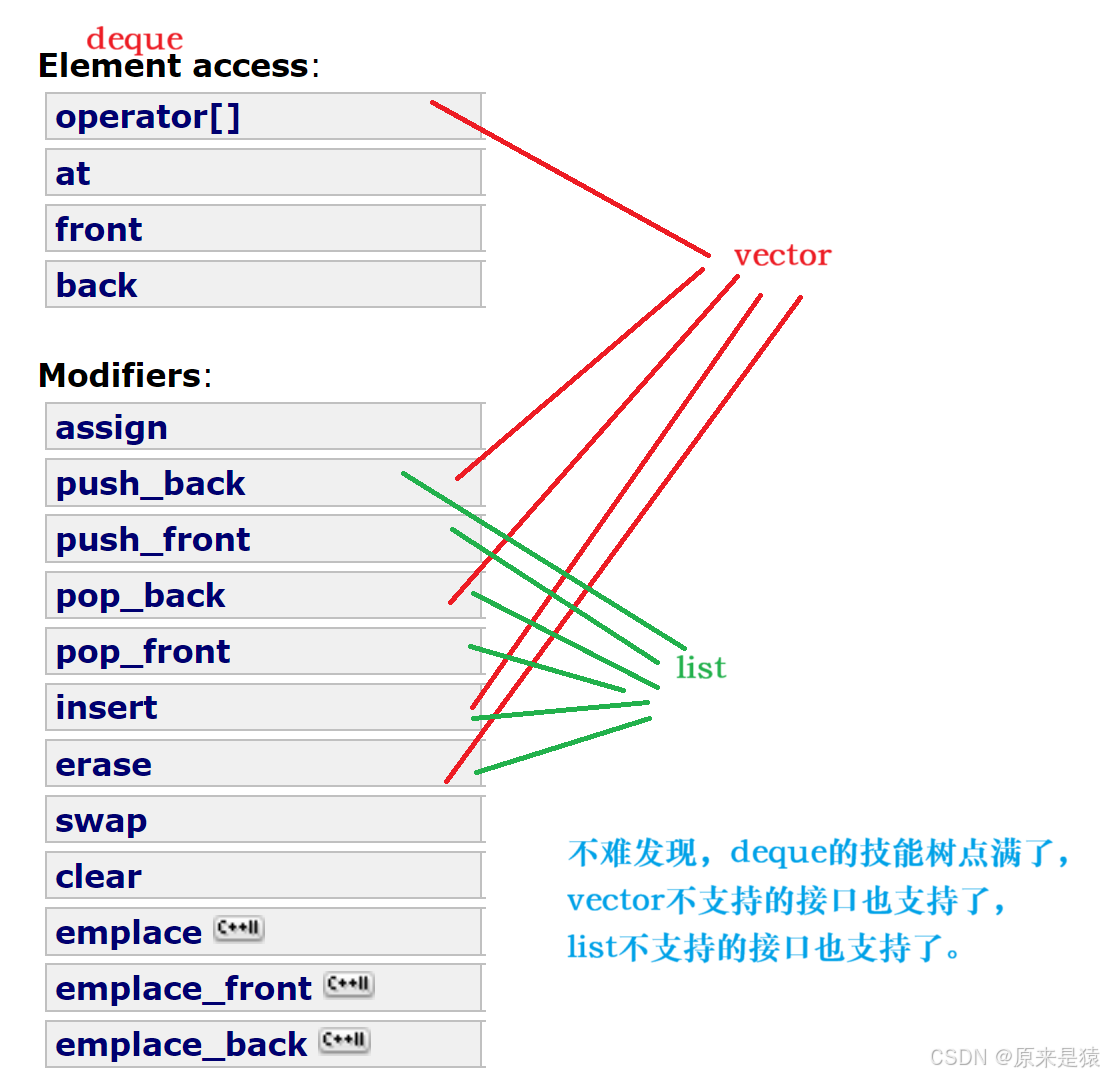

deque 并不是真正连续的空间,而是由一段段连续的小空间拼接而成的,实际deque类似于一个动态的二维数组,其底层结构如下图所示 :
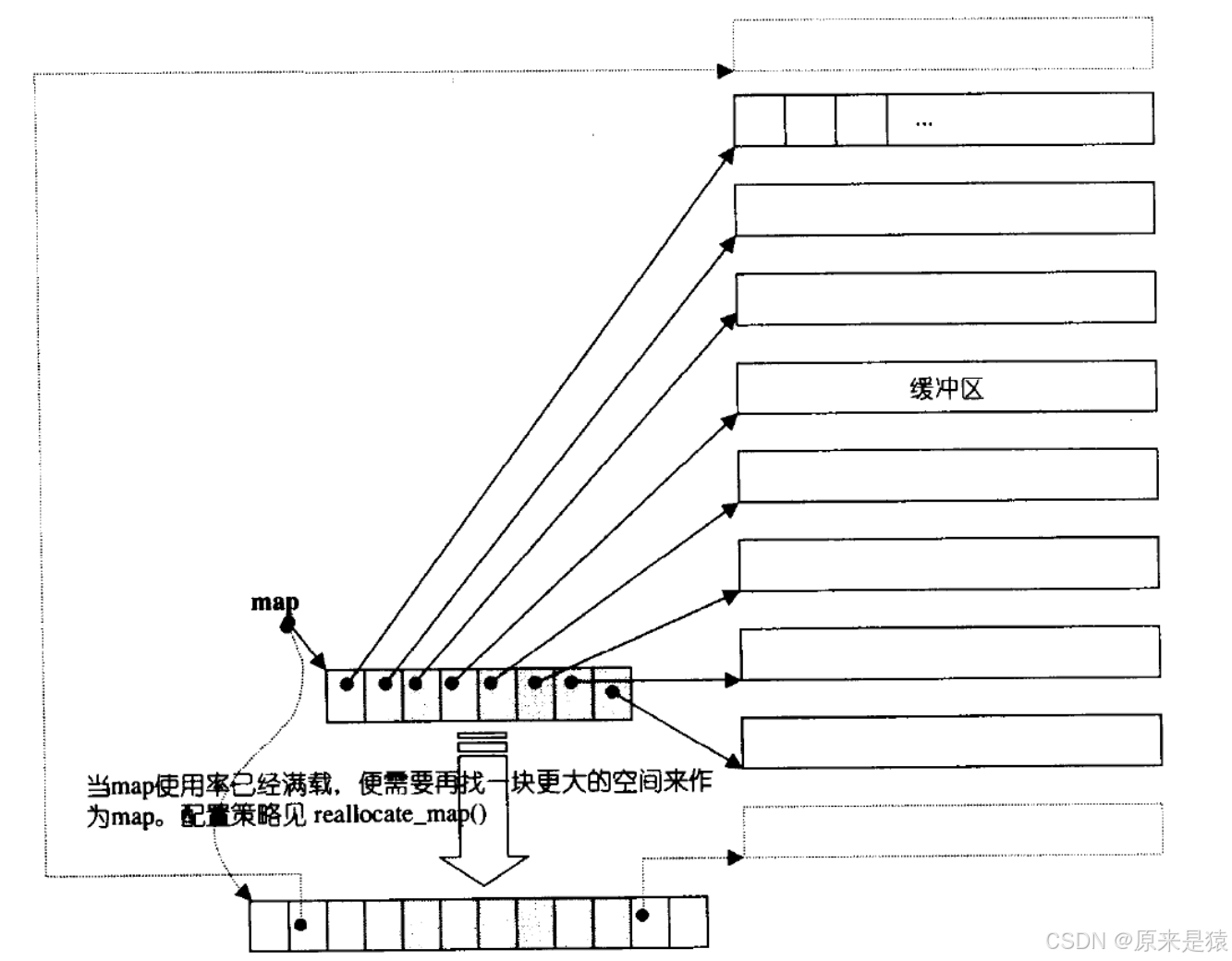
双端队列底层是一段假象的连续空间 , 实际是分段连续的 ,为了维护其 “整体连续” 以及随机访问的假象 , 落在了 deque的迭代器身上 , 因此 deque的迭代器设计就比较复杂 , 如下:
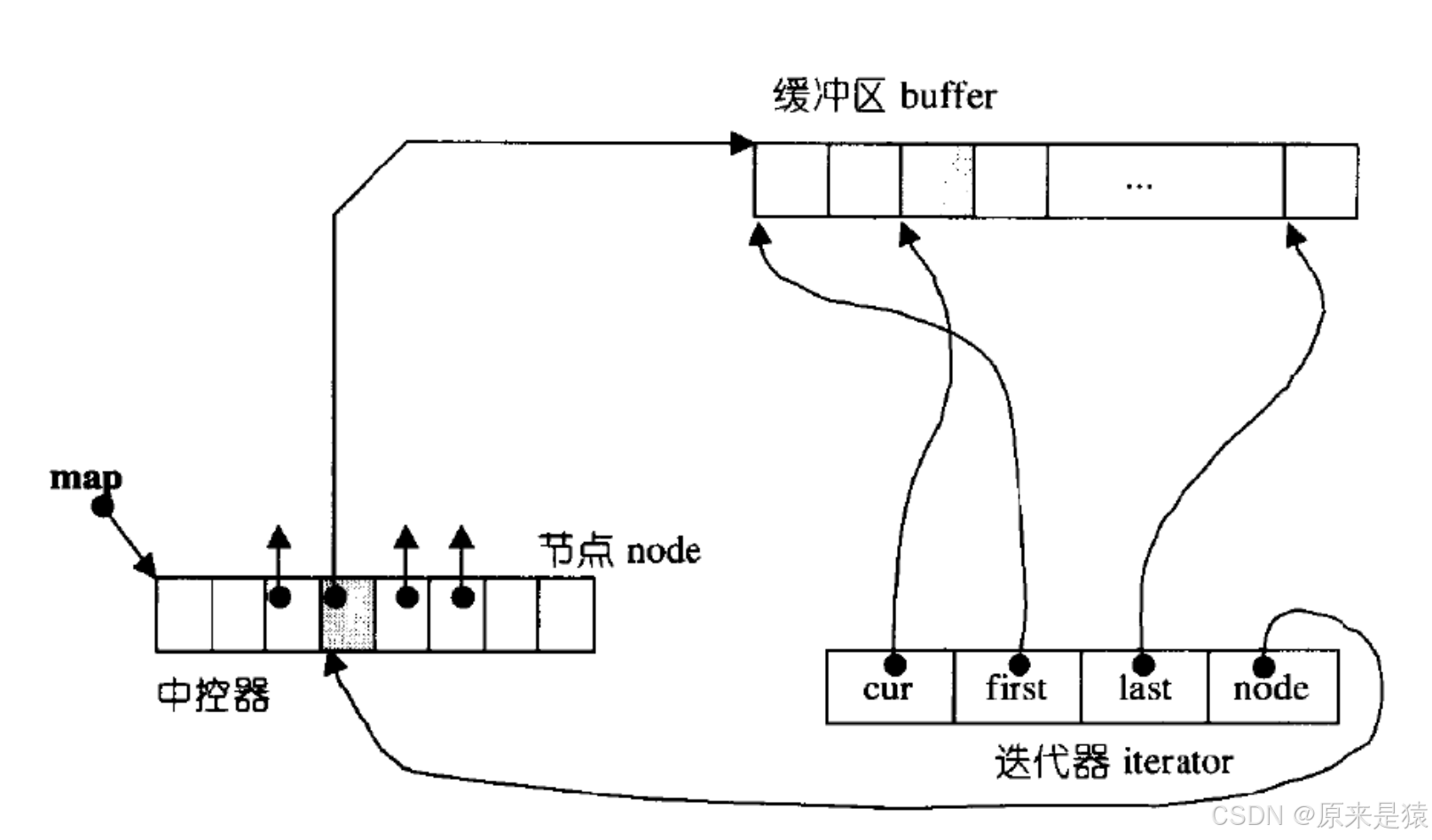
那deque 是如何借助其迭代器维护其假象连续的结构呢?
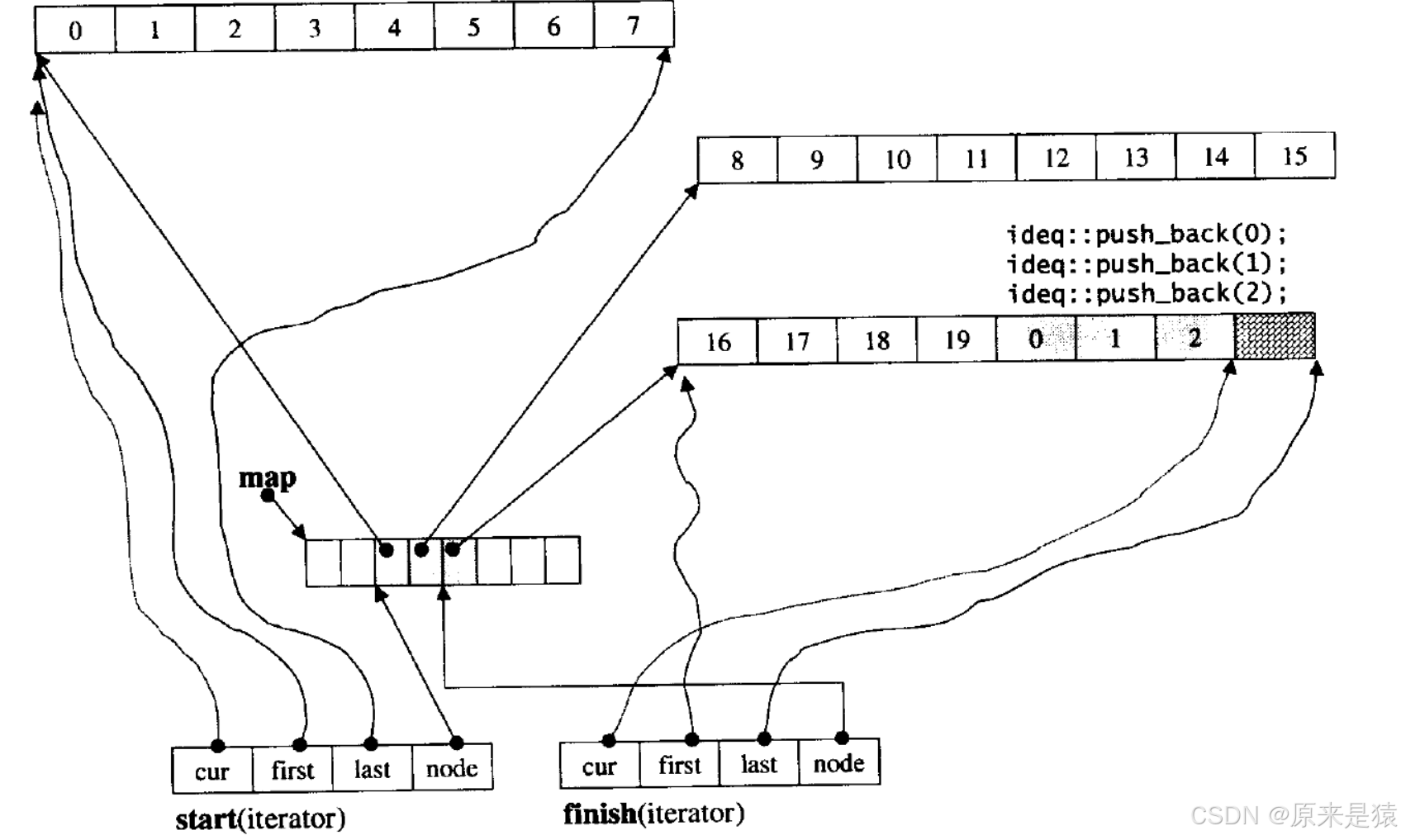
4.2 deque的缺陷
1. 与 vector 比较 , deque 的优势是 : 头部插入和删除时候 , 不需要搬移元素 , 效率特别高 , 而且在扩容时 , 也不需要搬移大量元素 , 因此其效率是比 vector 高。
2. 与list 比较 , 其底层是连续空间 ,空间利用率比较高 , 不需要存储额外字段 。
3. 但是, deque有一个致命的缺陷 :
不适合遍历 , 因为在遍历时 , deque 的迭代器要频繁的去检测其是否移动到某一段小空间的边界 , 导致效率低下 ,而序列式场景中 , 可能需要经常遍历 , 因此在实际中 , 需要线性结构时 , 大多数情况下 优先考虑 vector 和 list , deque 的应用并不多 , 而 目前能看到的一个应用就是 , STL用其作为stack 和 queue 的底层结构 。
4.3 为什么选择 deque 作为stack 和 queue的底层默认容器
1 . stack 是一种后进先出的特殊结构 , 因此只要具有 push_back() 和 pop_back() 操作的线性结构 , 都可以作为stack的底层容器 ,比如vector 和 list 都可以 。
2. queue 是 先进先出的特殊线性数据结构 , 只要具有 push_back() 和 pop_front() 操作的线性结构 , 都可以作为 queue的底层容器 , 比如 list 。
但是STL中对stack 和 queue 默认选择 deque 作为底层容器 , 主要是因为 :
1. stack 和 queue不需要遍历(因此 stack 和 queue没有迭代器),只需要固定的一端或者两端进行操作。
2. 在 stack 中元素增长时 , deque比vector 的效率高 (扩容时不需要搬移大量数据);queue中的元素增长时 , deque不经效率高 , 而且内存使用率高 。
结合了deque的优点,而完美的避开了缺陷
五、priority_queue
priority_queue - C++ Reference
5.1 priority_queue的介绍
1. 优先队列是一种 容器适配器 ,根据严格的弱排序标准,它的第一个元素 总是 它所包含的元素 中最大的。2. 此上下文类似于堆,在堆中可以随时插入元素,并且只能检索最大堆元素(优先队列中位于顶部的元素)。3. 优先队列被实现为容器适配器,容器适配器即将特定容器类封装作为其底层容器类,queue提供一组特定的成员函数来访问其元素。元素从特定容器的“尾部”弹出,其称为优先队列的顶部。
5.2 priority_queue的使用
优先级队列默认使用 vector作为其底层存储数据的容器,在vector上又使用了堆算法将vector中 元素构造成堆的结构,因此priority_queue就是堆,所有需要用到堆的位置,都可以考虑使用 priority_queue。注意:默认情况下priority_queue是大堆。
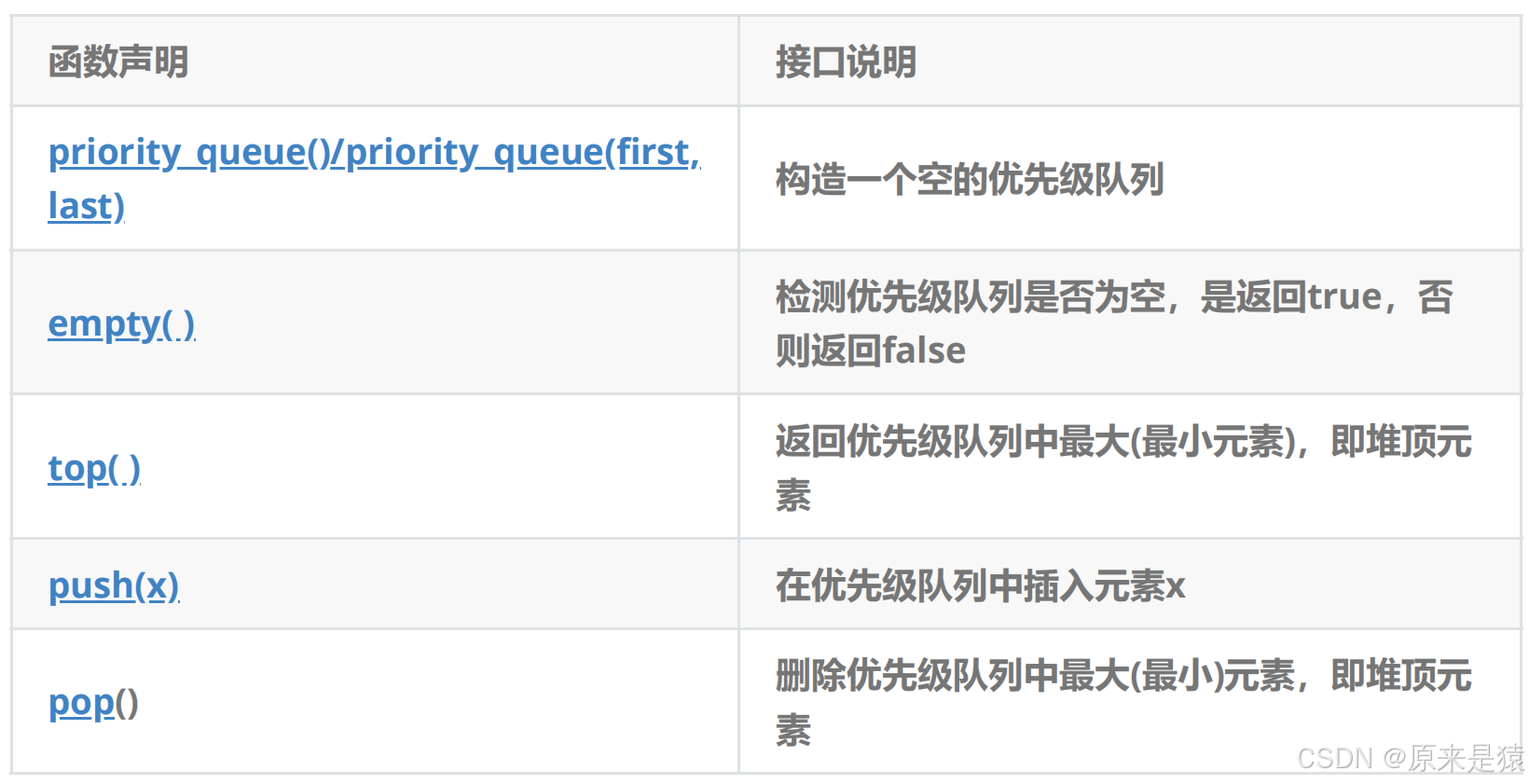
#define _CRT_SECURE_NO_WARNINGS 1
#include<iostream>
#include<queue>
using namespace std;int main()
{
//默认是大的优先级高priority_queue<int> pq;pq.push(15);pq.push(2);pq.push(31);pq.push(4);while (!pq.empty()){cout << pq.top() << " ";pq.pop();}cout << endl;return 0;
}

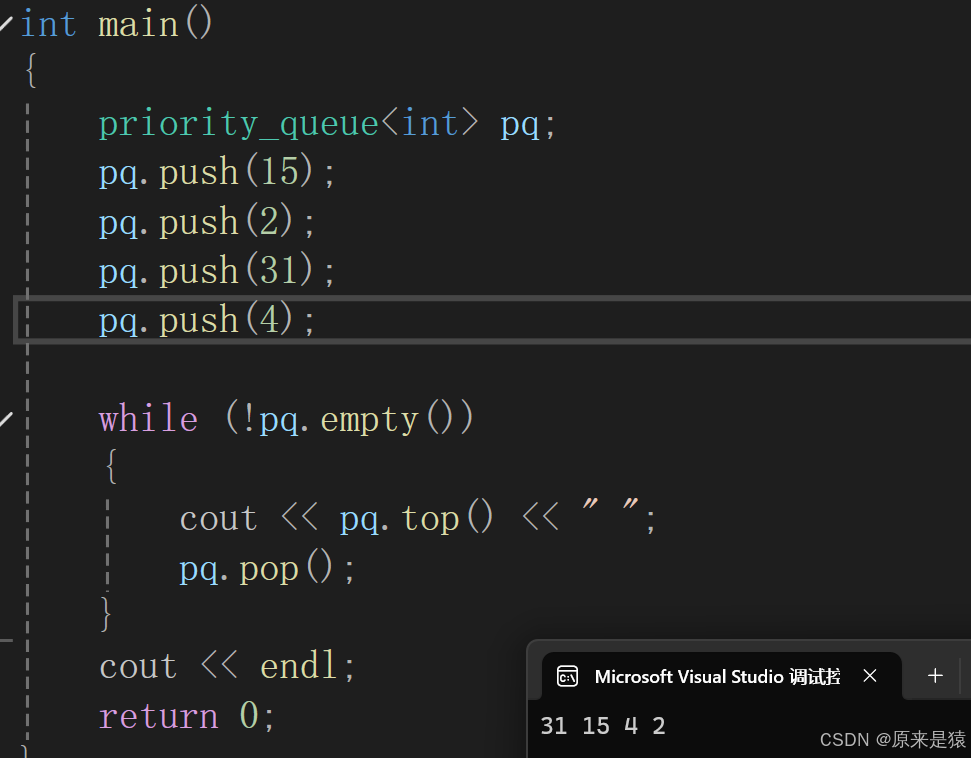
1)数组中第K个大的元素
215. 数组中的第K个最大元素 - 力扣(LeetCode)
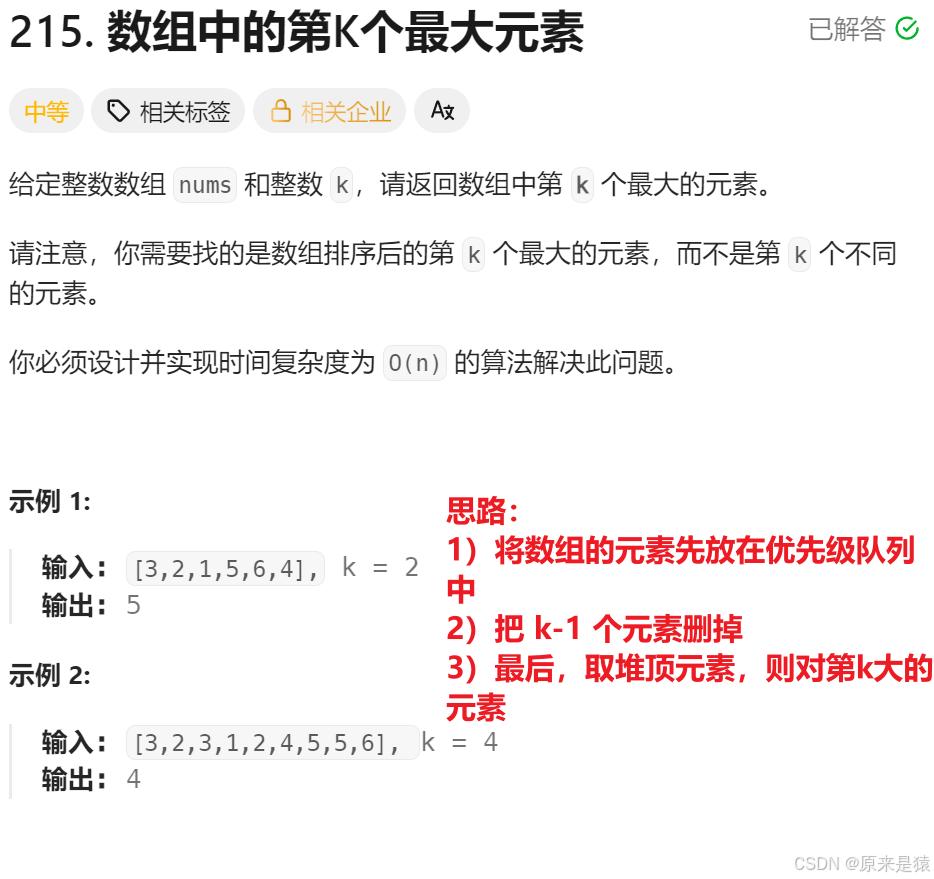
class Solution {
public:int findKthLargest(vector<int>& nums, int k) {priority_queue<int> p(nums.begin(),nums.end());while(--k){p.pop();} return p.top();}
};5.3 priority_queue的模拟实现
#pragma once
#include<vector>namespace bit
{template <class T>struct less {bool operator() (const T& x, const T& y) const{ return x < y;}};template <class T>struct greater{bool operator() (const T& x, const T& y) const{return x > y;}};template<class T, class Container = vector<T>, class Compare = less<T>>class priority_queue{public:// 强制生成priority_queue() = default;template <class InputIterator>priority_queue(InputIterator first, InputIterator last):_con(first, last){// 建堆for (int i = (_con.size()-1-1)/2; i >= 0; i--){AdjustDown(i);}}void AdjustUp(int child){Compare com;int parent = (child - 1) / 2;while (child > 0){//if (_con[parent] < _con[child])if (com(_con[parent], _con[child])){swap(_con[child], _con[parent]);child = parent;parent = (parent - 1) / 2;}else{break;}}}void push(const T& x){_con.push_back(x);AdjustUp(_con.size() - 1);}void AdjustDown(int parent){Compare com;size_t child = parent * 2 + 1;while (child < _con.size()){// 假设法,选出左右孩子中小的那个孩子//if (child + 1 < _con.size() && _con[child] < _con[child + 1])if (child + 1 < _con.size() && com(_con[child], _con[child + 1])){++child;}//if (_con[parent] < _con[child])if (com(_con[parent], _con[child])){swap(_con[child], _con[parent]);parent = child;child = parent * 2 + 1;}else{break;}}}void pop(){swap(_con[0], _con[_con.size() - 1]);_con.pop_back();AdjustDown(0);}bool empty(){return _con.empty();}const T& top(){return _con[0];}size_t size(){return _con.size();}private:Container _con;};
}







设计原则之开闭原则)
![[Linux入门] Linux 网络设置入门:从查看、测试到配置全攻略](http://pic.xiahunao.cn/[Linux入门] Linux 网络设置入门:从查看、测试到配置全攻略)










)